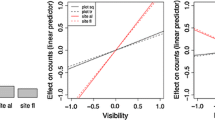Summary
Infra-red aerial photography was used on two occasions to map the abundance and dispersion of milkweeds (Asclepias spp.). The scale at which the aerial photographs could be interpreted showed that milkweeds occur in large contiguous areas or patches. These patches are abundant, the number in any size-class declining exponentially with increasing size. Analysis of the maps using various dispersion indices and spatial autocorrelation statistic showed that patches have a clumped dispersion. Large patches tend to be surrounded by smaller sized patches. The scales at which clumping occurred indicated a close association between milkweeds and the degree of disturbance of the ‘natural’ environment by human activities. The utility of resource mapping using aerial photography is demonstrated.
Similar content being viewed by others
References
Avery TE (1968) Interpretation of aerial photographs (2nd ed) Burgess Pub Co, Minneapolis
Caughley G (1970) Eruption of ungulate populations, with emphasis on the Himalayan thar in New Zealand. Ecology 52:53–72
Cliff AD, Ord JK (1973) Spatial autocorrelation. London Pion
Elphinstone GD (1972) Beaudesert Shire Handbook, Queensland Department of Primary Industy
Fisher RA (1953) Note on the efficient fitting of the negative binomial. Biometrics 9:197–200
Gilbert N, Gutierrez AP, Frazer BD, Jones RE (1976) Ecological Relationships. WH Freeman and Co. San Francisco
Hassell MP, Southwood TRE (1978) Foraging Strategies of Insects. Ann Rev Ecol Syst 9:75–98
Jumars PA, Thistle D, Jones ML (1977) Detecting two-dimensional spatial structure in biological data. Oecologia (Berl) 28:109–123
Just JM (1978) A study of the reproductive strategies of three species of Asclepias. Hon thesis AES. Griffith University
Katti SK Gurland J (1962) Efficiency of certain methods of estimation for the negative binomial and the Neyman type A distributions. Biometrika 49:215–226
Patil GP, Stiteler WM (1974) Concepts of aggregation and their quantification: A critical review with some new results and applications. Res Pop Ecol 15:238–254
Pielou EC (1969) An Introduction to Mathematical Ecology. J Wiley and Sons New York
Smith RAH, Allcock PJ (1979) An inexpensive method for producing grassland maps from colour slides. J Appl Ecol 16:589–594
Sokal RR, Oden NL (1978) Spatial autocorrelation in biology 1. Methodology. J Linn Soc (Biol) 10:199–228
Southwood TRE (1966) Ecological Methods. Chapman and Hall, London
Southwood TRE (1977) Habitat, the templet for ecological strategies? Presidential address to the British Ecological Society, 5 January, 1977. J Anim Ecol 46:337–366
Tamaki G, McGuide JU Jnr, Onsager JA (1973) Spatial distribution of the green peach aphid used in estimating the population of gynoparae. Res Pop Ecol 14:64–75
Wiens JA (1976) Population responses to patch environments. Ann Rev Evol Syst 7:81–120
Zalucki MP (1981) Animal movement and its population consequences, with a case study of Danaus plexippus. Ph D Thesis Griffith University
Author information
Authors and Affiliations
Rights and permissions
About this article
Cite this article
Zalucki, M.P., Chandica, A. & Kitching, R.L. Quantifying the distribution and abundance of an animals resource using aerial photography. Oecologia 50, 176–183 (1981). https://doi.org/10.1007/BF00348034
Received:
Issue Date:
DOI: https://doi.org/10.1007/BF00348034




